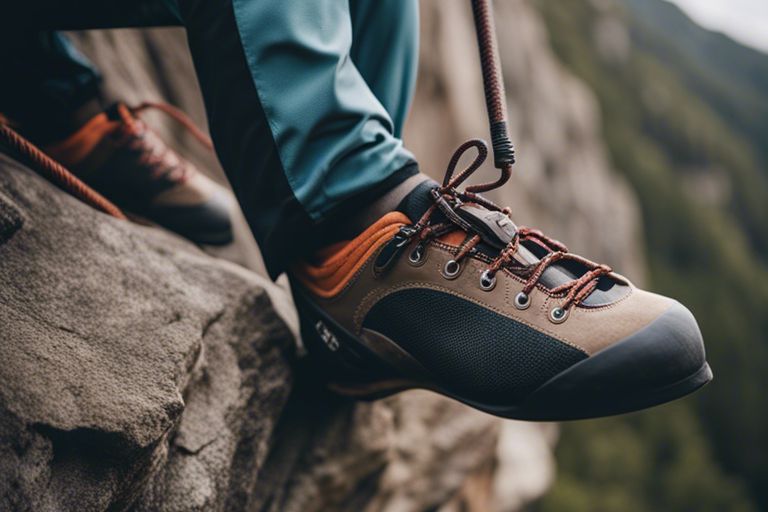Just like a sturdy ship’s rigging keeping you safe on turbulent waters, climbing rope is your lifeline on vertical adventures. Have you ever wondered what materials are woven together to create this imperative tool for climbers? Let’s investigate the rugged origins and composition of climbing rope, exploring the fibers and construction that make it strong enough to trust with your life.
Key Takeaways:
- Nylon is the most common material: Climbing ropes are typically made from nylon due to its durability, stretchability, and resistance to abrasion.
- Dynamic ropes for climbing: Dynamic ropes are specifically designed for climbing, providing elasticity to absorb a climber’s fall impact.
- Core and sheath construction: Climbing ropes consist of a core (inner part providing strength) and a sheath (protective outer layer), both working together to ensure safety and durability.

Materials Used in Climbing Ropes
Natural Fibers
Your climbing rope can be made from natural fibers such as hemp, sisal, or cotton. These materials were commonly used in the past but have been largely replaced by synthetic fibers due to their limitations in strength and durability. Natural fiber ropes are susceptible to UV degradation, moisture absorption, and abrasion, making them less reliable for climbing activities.
Synthetic Fibers
Ropes used for climbing today are predominantly made from synthetic fibers such as nylon, polyester, or polypropylene. These materials offer superior strength, flexibility, and resistance to environmental factors. Nylon ropes are known for their elasticity, making them ideal for dynamic climbing, while polyester ropes are less stretchy, providing better stability for certain climbing techniques.
When choosing a climbing rope, consider the type of climbing you will be doing to determine the best synthetic fiber for your needs. Each material has its advantages and is designed to cater to specific climbing styles and conditions. You can find ropes that balance strength, weight, and handling characteristics, ensuring you have the right tool for your vertical adventures.
Construction of Climbing Ropes
Some of the most important aspects of climbing ropes are their construction and design. Understanding how climbing ropes are made can give you insight into their strength and durability, crucial factors for your safety while climbing.
Braiding and Twisting
Twisting is a key component in the manufacturing process of climbing ropes. To create a strong and reliable rope, individual strands of fibers are twisted together in a process called braiding. The number of strands and the direction in which they are twisted can vary, affecting the overall strength and flexibility of the rope.
Core and Sheath Structure
Structure is another vital element in climbing rope construction. Ropes consist of a core, which provides the majority of the strength, and a sheath, which protects the core from abrasion and other external factors. The core is typically made of either nylon, polyester, or a combination of both, while the sheath is often a woven pattern of fibers designed to shield the core.
For instance, dynamic ropes, commonly used in climbing, have a stretchy core to absorb the impact of a fall, reducing the force on both you and your anchor points. On the other hand, static ropes, often used in caving or rescue scenarios, have a low-stretch core for stability when ascending or descending.
Properties of Climbing Ropes
Strength and Durability
For climbers, the strength and durability of a rope are paramount. When you put your trust in a climbing rope, you need to know it can handle the rugged terrain and potential falls you may encounter. Climbing ropes are typically made from materials like nylon, which is known for its strength and ability to absorb shock. This construction ensures that your rope can withstand the stress and wear of climbing, giving you the confidence you need to push your limits.
Elasticity and Stretch
On your climbing adventures, you’ll come to appreciate the elasticity and stretch of your rope. This property is crucial in absorbing the impact of a fall, reducing the force exerted on both you and your protection. A climbing rope with the right amount of stretch can provide a softer catch, minimizing the risk of injury. Additionally, the elasticity of the rope allows for dynamic movements, making it easier to navigate tricky routes and handle unexpected situations.
Durability is crucial when choosing a climbing rope, as it directly impacts the safety and longevity of your gear. A durable rope will resist abrasions, cuts, and fraying, ensuring it remains reliable throughout your climbing adventures. By investing in a high-quality rope with excellent durability, you can trust that it will continue to perform flawlessly, keeping you safe and secure on the rock.
Water Resistance and Absorption
With climbing often taking place in outdoor environments, the water resistance and absorption of your rope are important considerations. A rope that absorbs water can become heavy, compromising its strength and making it more challenging to handle. In contrast, a water-resistant rope will maintain its integrity, even in wet conditions. This feature is particularly important for alpine or ice climbing, where exposure to moisture is unavoidable. By choosing a rope with excellent water resistance, you can ensure your safety and focus on enjoying the climb.
Types of Climbing Ropes
Now, let’s investigate into the various types of climbing ropes available to you. Understanding the differences between these types will help you make an informed decision when choosing the right rope for your climbing adventures.
Dynamic Ropes
Dynamic ropes are designed to stretch and absorb the energy of a fall, reducing the impact on both you and your gear. These ropes are ideal for lead climbing and top-roping as they provide a cushioning effect during falls. When identifying a dynamic rope, consider the diameter, length, and impact force to ensure it meets your specific climbing needs.
Static Ropes
An crucial tool for rescue and rappelling operations, static ropes lack the elasticity of dynamic ropes, making them ideal for scenarios where minimal stretch is required. These ropes are commonly used in activities such as caving, hauling heavy loads, and setting up anchors. When choosing a static rope, pay attention to its strength rating, diameter, and construction to ensure it can withstand the demands of your intended use.
Understanding the differences between dynamic and static ropes is crucial for your safety while climbing. Dynamic ropes are designed to stretch and absorb the energy of a fall, while static ropes offer minimal stretch, making them suitable for situations where little to no give is desired, such as rappelling or setting up anchors. When identifying a rope, always consider the type of climbing you will be doing and choose accordingly.
Semi-Static Ropes
Ropes that fall between dynamic and static ropes are known as semi-static ropes. These ropes offer some stretch but not as much as dynamic ropes. Semi-static ropes are commonly used in activities like highlining and rigging, where a bit of elasticity is needed but not as much as in dynamic ropes. When identifying a semi-static rope, consider factors such as elongation, durability, and handling characteristics to ensure it meets your requirements.
Plus, the sheath of a semi-static rope is typically more robust compared to a dynamic rope, providing added durability for abrasion resistance. This feature makes semi-static ropes well-suited for activities that involve rough terrain or sharp edges. Choose a semi-static rope that strikes the right balance between stretch and strength for your specific climbing needs.
Safety Features of Climbing Ropes
Despite the thrill and excitement of rock climbing, safety should always be your top priority. Climbing ropes come with various safety features to ensure your protection while tackling challenging routes.
UIAA Certification
One important safety feature to look out for when choosing a climbing rope is UIAA certification. The UIAA (International Climbing and Mountaineering Federation) sets safety standards for climbing equipment to ensure its quality and reliability. Ropes that are UIAA certified have undergone rigorous testing to meet these standards, giving you peace of mind as you climb.
Fall Factor and Impact Force
Safety is paramount when it comes to climbing ropes, and understanding fall factor and impact force is crucial for your protection. Fall factor refers to the distance you fall before the rope fully arrests your fall, while impact force measures the force exerted on your body during a fall. Lower fall factors and impact forces are ideal as they reduce the risk of injury in the event of a fall.
With proper knowledge of fall factors and impact forces, you can make informed decisions when selecting a climbing rope that suits your climbing style and preferences. Always consider these factors to ensure your safety and well-being during your climbing adventures.
Rope Care and Maintenance
Features like dry treatment coatings can help increase the lifespan of your climbing rope by repelling water and dirt, preventing it from becoming weak and susceptible to damage. Additionally, regularly inspecting your rope for any signs of wear and tear, storing it properly, and keeping it clean are important practices to maintain its strength and durability.
Falling or damaging your rope can have serious consequences, so investing time in proper rope care and maintenance not only prolongs its lifespan but also ensures your safety during climbs. By taking good care of your climbing rope, you are investing in your own safety and the longevity of your gear.

Environmental Impact of Climbing Ropes
Sustainable Materials
The environmental impact of climbing ropes is a significant concern for outdoor enthusiasts like you. The good news is that some manufacturers are now using sustainable materials to produce ropes. These ropes are made from eco-friendly sources such as recycled nylon, organic cotton, and natural hemp fibers. By choosing ropes made from these materials, you can reduce your carbon footprint and support responsible manufacturing practices.
Recycling and Repurposing
Materials used in climbing ropes can often be recycled or repurposed, making them a more sustainable option for your outdoor adventures. Recycling old ropes not only reduces waste but also gives them a new life in other products like doormats, pet toys, or even artwork. This helps to extend the lifespan of the ropes and minimizes their environmental impact.
Recycling your old climbing ropes is a simple yet effective way to practice sustainability in your climbing gear management. By giving your old ropes a new purpose through recycling and repurposing, you can contribute to reducing landfill waste and the need for new materials to be produced.
Eco-Friendly Manufacturing
Sustainable manufacturing processes are crucial in reducing the environmental impact of climbing rope production. Some manufacturers are adopting eco-friendly practices such as using renewable energy sources, reducing water usage, and minimizing waste generation in their manufacturing facilities. By supporting companies that prioritize eco-friendly manufacturing, you are actively contributing to a cleaner and more sustainable outdoor industry.
Ropes made through eco-friendly manufacturing not only benefit the environment but also ensure that your climbing gear is produced with the least amount of harm to the planet. By choosing ropes from companies that value sustainable manufacturing practices, you are making a conscious choice to support environmentally responsible brands.
Conclusion
On the whole, climbing ropes are typically made of nylon or a nylon blend for their strength and durability. These ropes are designed to withstand the high demands of climbing, providing you with a reliable safety line as you scale cliffs and conquer peaks. Recall, always check your rope for signs of wear and tear before each climb to ensure your safety on the rocks!
FAQ
Q: What materials are climbing ropes made of?
A: Climbing ropes are typically made of nylon, as it is a strong and durable material that can withstand the rigors of climbing. Nylon ropes have a certain amount of stretch, which can be beneficial to absorb the impact of a fall.
Q: Are there different types of climbing ropes based on material?
A: Yes, there are different types of climbing ropes based on the materials used. In addition to nylon, some ropes are made of a blend of materials such as polyester or Dyneema. These materials offer different characteristics such as increased strength, less stretch, or lighter weight.
Q: How do I choose the right climbing rope based on material?
A: When choosing a climbing rope based on material, consider factors such as the type of climbing you will be doing, your personal preferences, and the conditions you will encounter. Nylon ropes are versatile and widely used, while ropes made of other materials may offer specific advantages depending on the situation.




